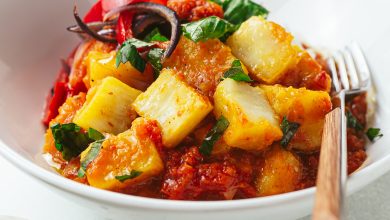Locust Bean Stew (Iru Stew)
A Flavorful West African Delight
Locust bean stew, known for its rich, savory flavor, is a beloved dish in many West African kitchens. This traditional recipe is packed with a variety of meats, smoked fish, and the earthy taste of locust beans (iru), all simmered together in a tantalizing blend of spices. Often enjoyed with rice, yam, or plantains, this dish brings warmth and satisfaction to any meal.
Ingredients
| Ingredient | Quantity |
|---|---|
| Bell Peppers (Tatashe) | 4 large |
| Scotch Bonnet Peppers (Ata Rodo) | 2-3 peppers |
| Onions | 1.5 onions |
| Palm Oil | 1 cup |
| Assorted Meats (Boiled and Fried) | As desired |
| Locust Beans (Iru) | 1 cooking spoon |
| Smoked Fish (Shredded) | As desired |
| Stockfish (Shredded) | As desired |
| Ponmo (Cow Skin) | As desired |
| Boiled Eggs | As desired |
| Knorr Chicken Cubes | 2 cubes |
| Salt | To taste |
Allergen Information
This dish contains ingredients that might be of concern to those with allergies or dietary restrictions, such as:
- Palm oil: A source of fat, often used in traditional African cooking.
- Meats: May contain various proteins that could trigger allergies.
- Smoked fish and stockfish: Can be allergens for those sensitive to seafood.
- Ponmo (Cow skin): Typically safe for most, but it may be avoided by those with a preference for vegetarian or vegan diets.
Always check with your guests regarding allergies before preparing and serving this dish.
Dietary Preferences
- Paleo-Friendly: This recipe can be suitable for those following a paleo diet if made with unprocessed meats and no additional sweeteners.
- Low-Carb: It is naturally low in carbs, as it focuses on meats and fats.
- Non-Vegetarian: Contains meats, fish, and eggs, making it unsuitable for vegetarians or vegans.
- Gluten-Free: The recipe does not contain gluten, so it is safe for those with gluten intolerance.
Preparation Instructions
-
Prepare the Ingredients
Begin by coarsely blending the bell peppers (Tatashe), Scotch bonnet peppers (Ata Rodo), and 1.5 onions. Set the blended mixture aside. -
Heat the Palm Oil
Pour the palm oil into a saucepan and place it over medium heat. Allow the oil to heat up until it starts to shimmer. -
Fry the Onions
Once the palm oil is hot, add half of the chopped onions to the oil. Stir and fry for 2 minutes, ensuring the onions soften and release their aroma. -
Add the Locust Beans
After 2 minutes, add the locust beans (Iru) to the oil and fry for an additional 2 minutes. This step allows the locust beans to infuse their flavor into the oil, creating a rich base for the stew. -
Incorporate the Blended Peppers
Add the coarsely blended bell peppers and Scotch bonnet pepper mixture to the pan. Stir well to combine. Season the stew with the stock cubes and salt to taste. Let the stew simmer and boil for a few minutes as the flavors begin to meld. -
Add the Ponmo
Once the stew has started to boil, add the ponmo (cow skin) to the mix. Stir to incorporate it into the stew, and let it cook for 20 minutes, stirring occasionally to prevent burning. -
Simmer the Stew
After 20 minutes of cooking, the oil should rise to the surface, signifying that the stew is well on its way to being ready. At this point, add the shredded smoked fish, stockfish, assorted meats, and boiled eggs to the stew. -
Slow Cook and Fry
Allow the stew to cook on low heat, letting it fry gently for an additional 30 minutes. If you prefer a more intense, deep flavor, you can continue frying for up to an hour. Just ensure there’s enough palm oil in the pan and the heat remains low. Stir occasionally to prevent sticking and burning. -
Serve
Once the stew is cooked to your desired consistency and richness, remove from heat. Serve with your favorite accompaniment, such as rice, yam, or plantains, for a complete meal.
Tips and Advice
- Adjust the Spice Level: Scotch bonnet peppers are very spicy, so adjust the amount to suit your heat tolerance. If you prefer a milder version, use fewer peppers or remove the seeds before blending.
- Use Fresh Locust Beans: If you can’t find locust beans (Iru), try looking for them in African or international grocery stores. They are a key ingredient, giving the stew its signature flavor.
- Frying Time: The longer you fry the stew, the deeper the flavors will become. However, it’s important to cook it on low heat to avoid burning the palm oil.
- Experiment with Meats: While this recipe calls for assorted meats, you can customize it to your preference. Some variations include adding goat meat, chicken, or offals for an even richer flavor.
- Storage: This stew can be stored in an airtight container in the refrigerator for up to 3 days. It often tastes even better the next day when the flavors have had time to meld together.
Conclusion
Locust bean stew (Iru Stew) is a comforting, hearty dish that brings the rich, savory flavors of West Africa right to your table. Packed with an array of meats, fish, and the unique taste of locust beans, this stew is sure to be a crowd-pleaser. Whether you’re serving it for a family dinner or a special occasion, it offers a satisfying meal that’s both delicious and nourishing. Don’t forget to adjust the spice level and cooking time to make it your own!



